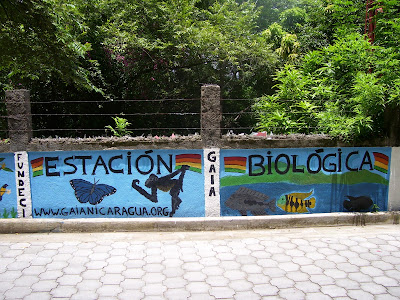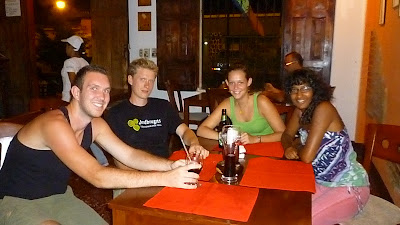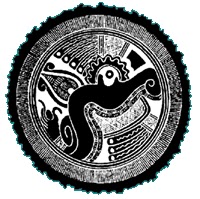near the shore of Laguna de Apoyo. We work with
, researchers, the local community, the civil society and government to advocate the protection of
. We provide lodging, birdwatching tours,
to individuals and groups.
 |
| Volunteers from Goshen College painted this mural during their study abroad semester. Photo by Jeffrey McCrary. |
Estacion Biologica is operated by the Nicaraguan Foundation for Integral Community Development (
FUNDECI). We are a not-for-profit organization registered by the Nicaraguan government since 1973. The first project of FUNDECI, construction of a small settlement on the edge of Leon, benefitted displaced people from the devastating
1972 Managua earthquake. FUNDECI works throughout Nicaragua today, with principal projects in Santa Teresa, Leon, Matagalpa, Managua, and our project in Laguna de Apoyo, which is divided among seven municipalities.
 |
| Our mascot, Heinz, is a rescue animal. He is a White-throated Magpie-Jay. He enjoys our kitchen and dining area, and often comes back to visit with us. Photo by Henryk Madsen. |
The facilities at Estacion Biologica are found in a set of properties along the shore of the crater lake, Laguna de Apoyo. All the houses we occupy were built before the area was officially designated a Protected Area by the Nicaraguan government. There is great conflict in
Laguna de Apoyo Nature Reserve regarding the rights of landowners, particularly non-Nicaraguans, who want to clear their land of wilderness and place a house on it. Of all the many threats to this protected area, this one is the greatest.
 |
| Simba and Bela serve as our welcoming committee for new arrivals to Estacion Biologica. Photo by Henryk Madsen. |
Inside Nicaragua, our group is well-known as the premier research team on biodiversity issues. Our group has published dozens of scientific research reports on several taxonomic groups. We have
discovered several species of fish in the lake. Our team worked extensively on the
first official management plan to be approved for the area, and we provide logistical assistance to the park rangers and police whenever they request it.
 |
| The facilities at Estacion Biologica are integrated into the environment. Photo by Henryk Madsen. |
We have lodging for individuals or groups of up to twenty people. We serve breakfast, lunch and dinner daily, and great coffee is always on hand. If you are looking for a hostel for overnight stay in Laguna de Apoyo, we have a room waiting for you, near the water where you can swim day or night. You don't have to be a volunteer or scientist to visit us, any
consciencious tourist is welcome!
 |
| A view of the forest in Laguna de Apoyo Nature Reserve. Photo by Henryk Madsen. |
Inside the volcanic crater, there is tropical dry forest, in which rain is concentrated during the months May to November, and the remaining months have almost no rain. Trees and wildlife must have strategies for their water needs during the dry season.
 |
| Lake Apoyo, Nicaragua. Photo by Henryk Madsen. |
The lake spans four kilometers and reaches nearly two hundred meters deep. Animals in the lake are isolated from other aquatic habitats, and several species of fish (members of the
Midas cichlid species complex in the genus
Amphilophus) have evolved during the existence of the lake. It's a great place for humans to swim, too.
 |
| A howler monkey travels through the yard at Estacion Biologica. |
Wildlife is abundant in the area. Among the more common mammal sightings are howler monkeys and variegated squirrels. Both can be seen in the yard most days. Also to be seen for the keen eye: paca, agouti, jaguarundi, grison, capuchin monkeys, white-tailed deer, nine-banded armadillo, Virginia opossum, Central American woolly opossum, and numerous bats and smaller rodents.
 |
| Dragon fruit is called pitahaya in Nicaragua, where it is native. The pitahaya plant is an epiphytic cactus, living on rocks and branches of trees. This one is in the yard of Estacion Biologica. Photo by Henryk Madsen. |
The towering trees of the forest extend into the yard of Estacion Biologica. Our property enjoys the shade of about twenty tree species native to the forest of our Reserve. We grow and plant native trees in the deforested areas of the reserve, and we encourage the appreciation of native trees among land owners and the government.
 |
| Among our work is rescuing wild animals in need of intervention. This bird was one of our rescue animals. He now lives in the forest, but returns to visit us often. Photo by Henryk Madsen. |
We at Estacion Biologica work closely with the Ministry of Natural Resources and the Environment, the municipal governments, and the National Police to keep Laguna de Apoyo Nature Reserve wild and natural, and its community prosperous. We work with volunteers, so you might want to join us and
volunteer.
 |
| Volunteers from Estacion Biologica enjoying a visit to Masaya. Photo by Henryk Madsen. |
Please visit us! We look forward to meeting you and discussing what we do.









1 comment:
Wonderful pictures. Happy holidays to everyone there!
Post a Comment